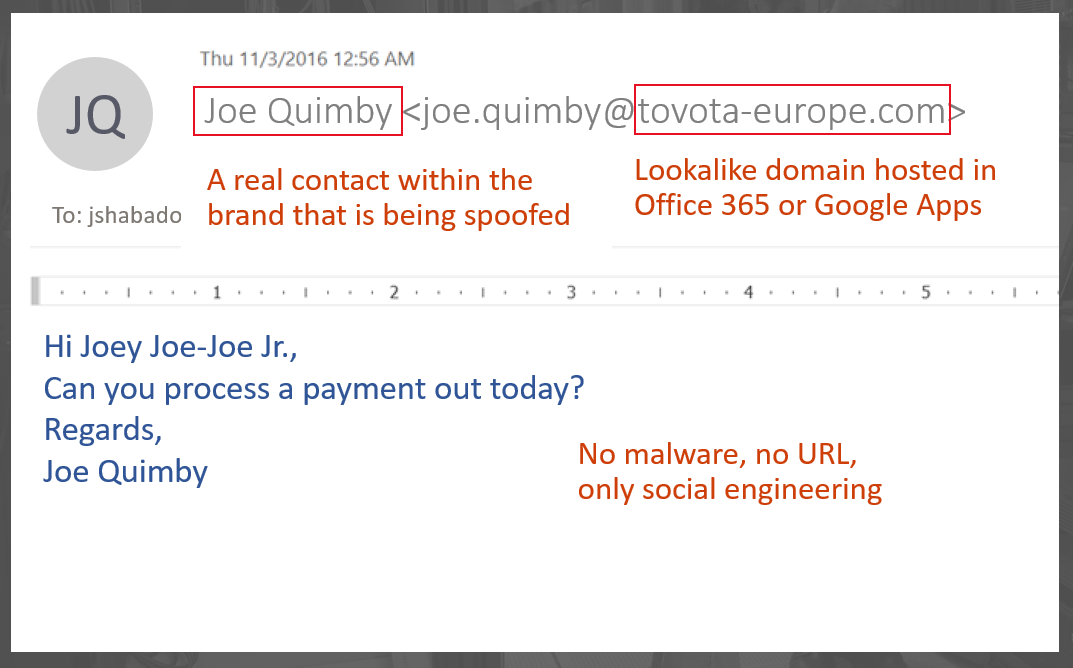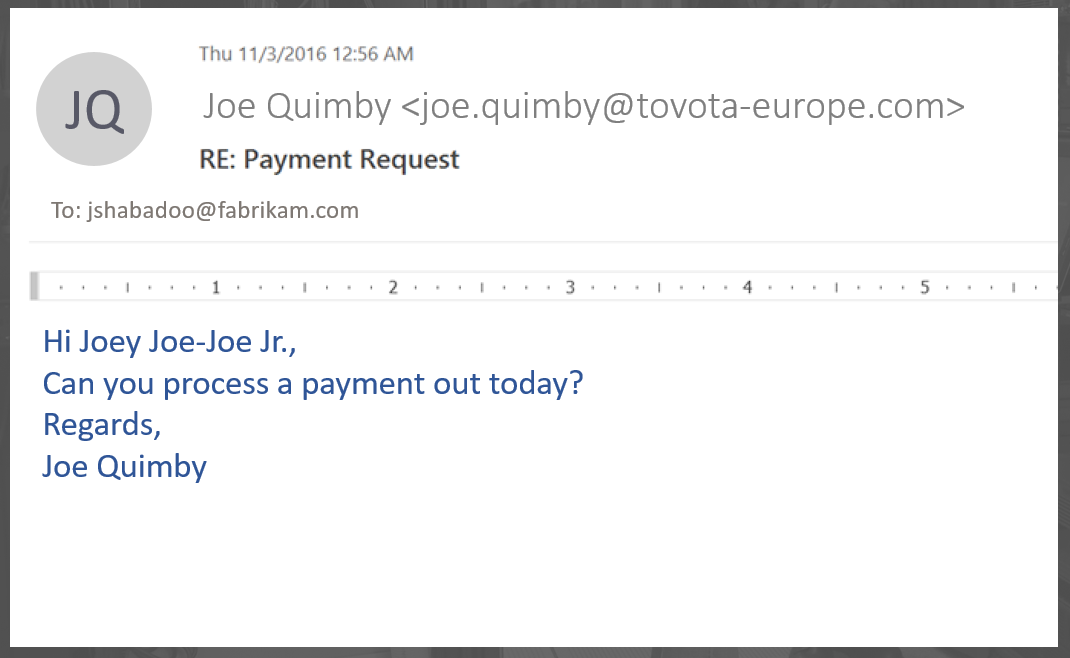Where email authentication falls flat at stopping phishing - impersonation attacks using display tricks
In this series so far, we've seen how email authentication is a great thing at stopping phishing under some circumstances, and where it isn't that useful in other circumstances. A circumstance where it isn't that useful is a variant of Business Email Compromise (BEC) that we call an Impersonation Attack. An Impersonation Attack is when the phisher uses a visual display trick and makes you think that who you are communicating with is a person that you know, but in reality is not that person.
You may think "That's what Business Email Compromise is" and you're right, but those can be further classified into Exact-Domain attacks (where the sender and recipient domain is the same), or Springboard attacks (where the sender and recipient have a relationship, but the sender domain is spoofed).
An Impersonation Attack is more general and makes use of many different techniques to fool the user:
- The message has a lookalike sending domain: where one letter is substituted for another
- One letter is substituted for another, microsoft.com vs. micros0ft.com
- Two letters are substituted for a single, nn -> m, cl -> d, rn -> m, and so forth
- The letters are rearranged where your eyes gloss over, mircosoft.com
- The letters in the sender domain use different charsets
- The message is sent from a free email account using the name of a high ranking executive in the Display Name, but the email address is completely random
- And so forth
But, what sets them apart is that the sending domain is not being spoofed.
For example:
In this above example:
- The sender domain, tovota-europe.com, is a lookalike of a real domain, toyota-europe.com, which is a real domain and brand associated with Toyota. If you weren't looking closely you wouldn't have noticed. The example below is a real message, and the phisher actually registered the domain with a registrar
. - The sender's display name is a real contact within the actual organization
. - The sending domain is hosted on legitimate infrastructure, such as Office 365 or Google Apps (or some other place that regularly hosts email). This happens because these services offer free sign ups with low messaging limits, but as a phisher you don't need a lot of email to send out, you just need legitimate infrastructure to avoid IP reputation lists
. - The contents of the message contain no malware nor URL, it's text-based. That makes it harder for filters to find malicious content
The key point is #1 and #2. The phisher has registered this domain for the intent of sending phishing messages, and they have even set up SPF records for the domain. Using email authentication to detect this as a spoof will fail, because it is not spoofing the domain; instead, it is spoofing the brand by using a heuristic that is easy for humans to interpret (and be fooled by), but hard for machines to interpret meaningfully. The filters do not have a lot of content to pick up, and the sending infrastructure is legitimate.
The Impersonation Attack is one of the more difficult phishing attacks to defend against.

.
Stopping Impersonation Attacks with techniques other than email authentication
Disclaimer: As I say in other blog posts where we haven't released the protection yet to the general public, this is me theorizing about how something could be done, not that it will be done this way.
One method that we are thinking about within Office 365 is leveraging Safety Tips to give users visual warnings when something in their email stream is out of place.
Edit 2016-01-12 - I've had to remove this part, will put it back later when we come up with something more concrete.
Conclusion
At this point, we've seen where email authentication is useful in the fight against phishing. However, we should not be lulled into a false sense of security that it solves all spoofing or phishing problems.
But what it does do is tighten up the perimeter so we can be more strict about enforcing security, forcing the cost of spamming to go up. That means the title of this post is incorrect; while email authentication falls flat when fighting Impersonation attacks, what it can do is drive a wedge into unauthenticated email and force phishers and spammers into places where they can be identified instead of hiding behind a mask.
There is no such thing as perfect security, only defense-in-depth. We use email authentication to protect ourselves, protect others from us being spoofed, and then add in other pieces of technology to stop the rest.
Comments
- Anonymous
March 01, 2017
I'd love to see what the removed section proposed. One thing that Microsoft could do that would help a little bit is to provide an option in Outlook to show the from email address in addition to the display name. Currently you need to mouse over the display name in order to see that from address. This could be hilighted. Another option that would be useful would be to allow color coding of display names from our domain and from other domains. For example, if the sender is from our domain (verified with dkim) display the name in green, otherwise display in orange or red. This would be a huge huge help! - Anonymous
June 08, 2017
+1 on Scott's comment.
